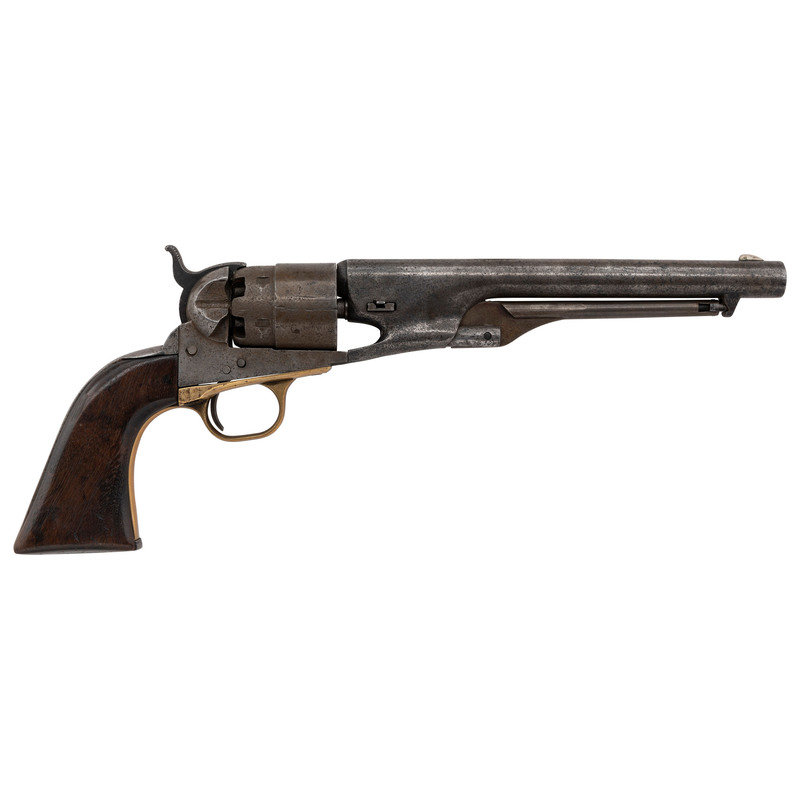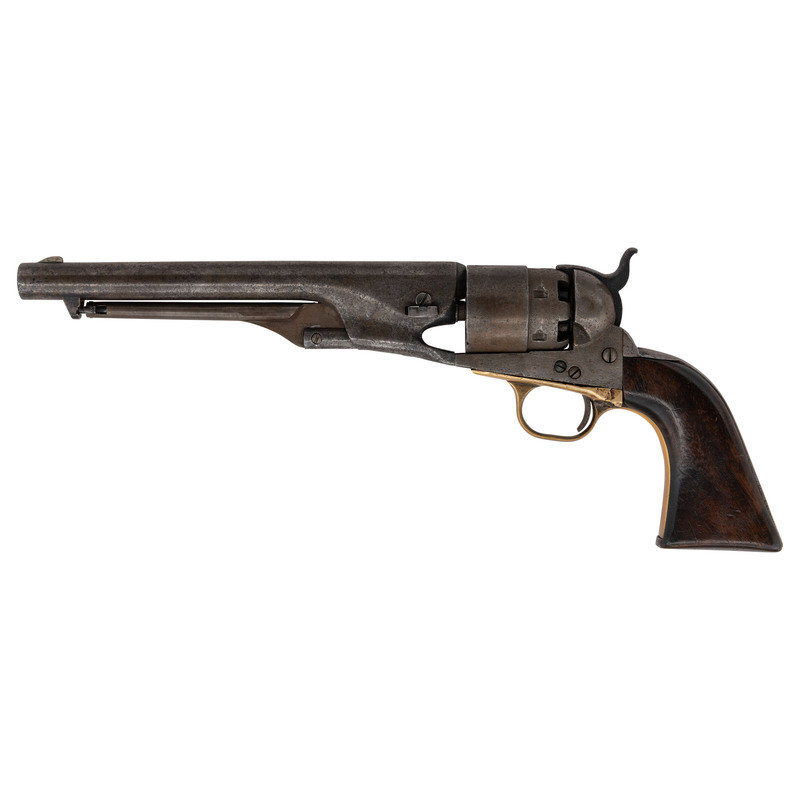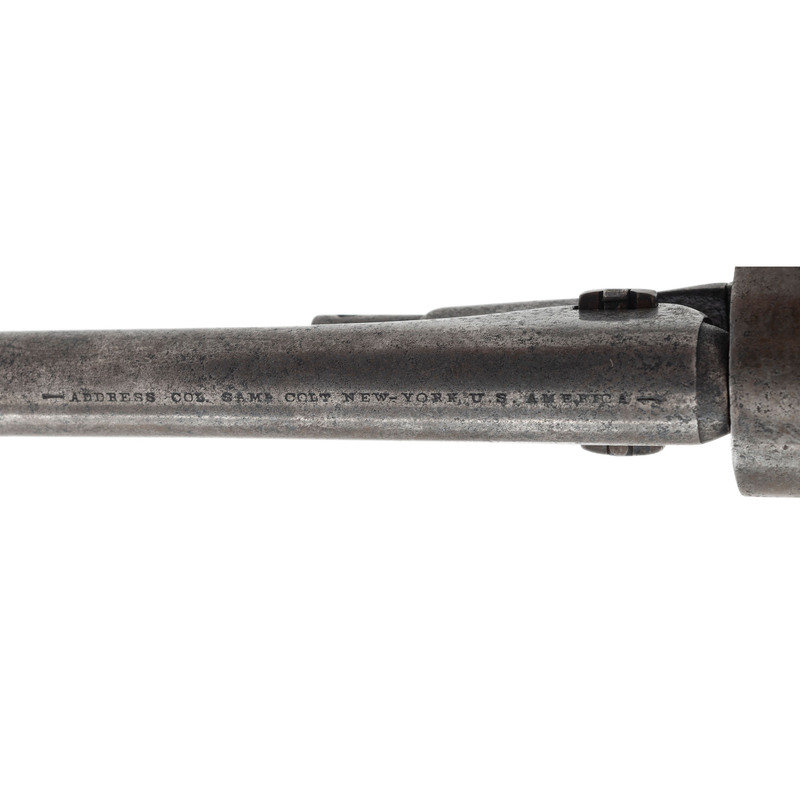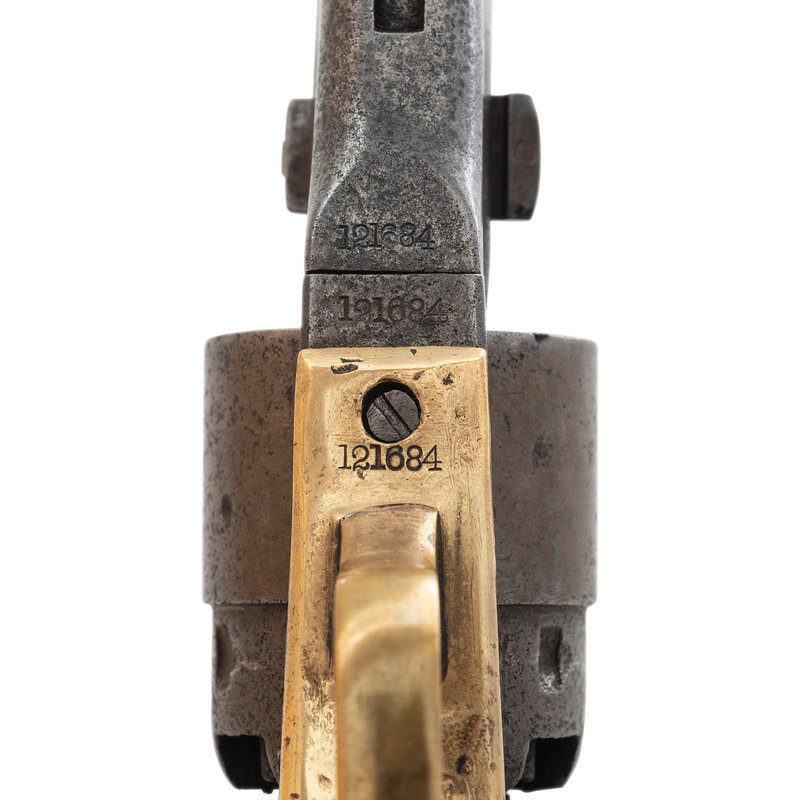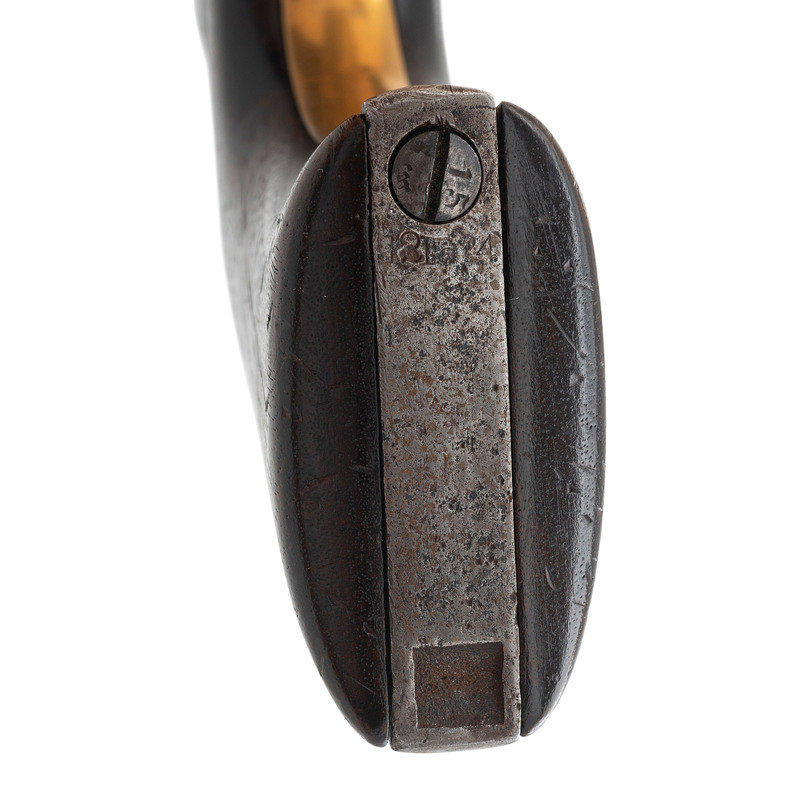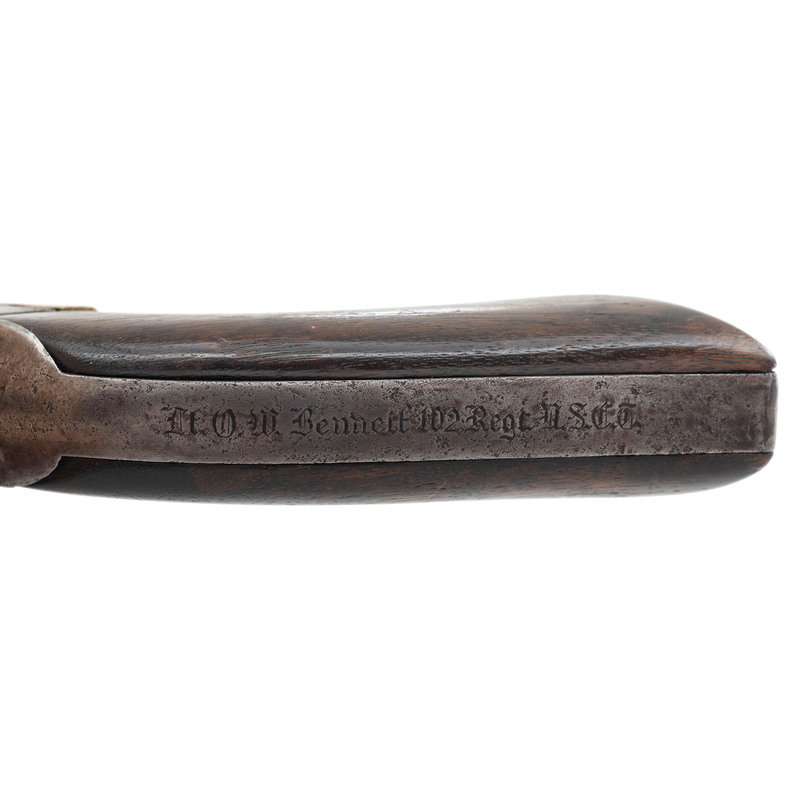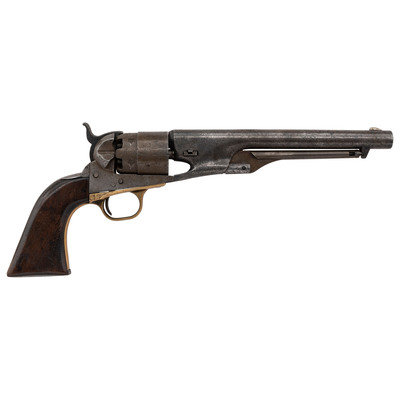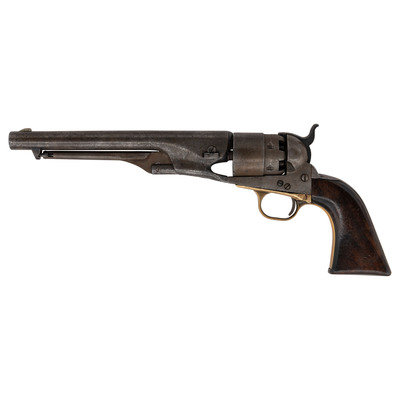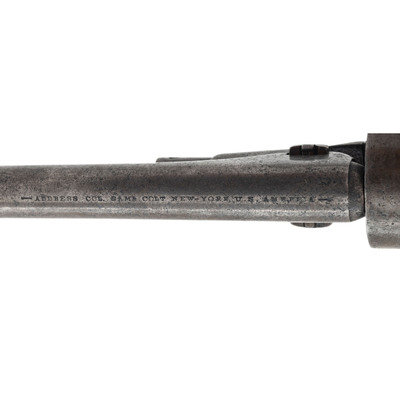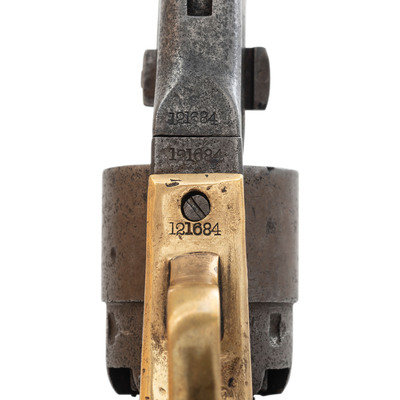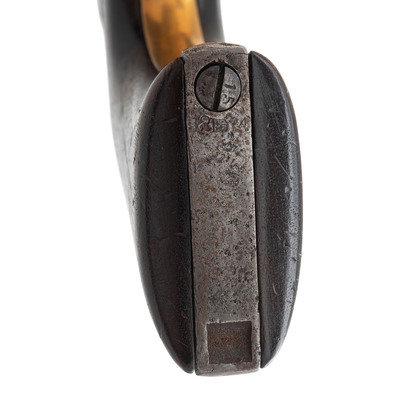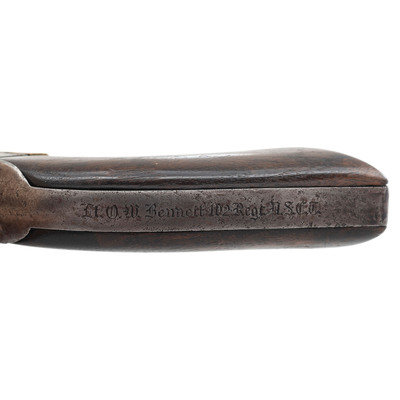Condition Report
Contact Information
Auction Specialists
Lot 75
Colt Model 1860 Inscribed to Medal of Honor Recipient Orson W. Bennett
Sale 1353 - Arms, Armor and Militaria
May 1, 2024
10:00AM ET
Live / Cincinnati
Own a similar item?
Estimate
$2,000 -
4,000
Price Realized
$8,400
Sold prices are inclusive of Buyer’s Premium
Lot Description
Colt Model 1860 Inscribed to Medal of Honor Recipient Orson W. Bennett
Recieved the Congressional Medal of Honor for His Actions in the Battle of Honey Hill in Command of a Squad of the 102nd US Colored Troops
American Civil War
.44 Cal. 8" barrel length. SN: 121684. Gray chemically cleaned appearance overall mounting brass triggerguard, iron backstrap, and varnished walnut one piece grips. Single-action percussion revolver inscribed along the backstrap to Congressional Medal of Honor recipient Orson W. Bennet. Majority of serial numbers match, but the arbor pin is not numbered, backstrap serial is largely obliterated, and the cylinder serial number has eroded completely. Left frame displays COLTS/PATENT marking with the top of the barrel struck by the standard single-line address reading -ADDRESS COL. SAML COLT NEW-YORK U.S. AMERICA- behind a German Silver front blade. Backstrap is inscribed in Gothic style block letters Lt. O.W. Bennett 102 Regt. U.S.C.T. Markings in this style are seldom encountered in presentation pieces to Civil War veterans. The loading lever and wedge pin are modern replacements, as are the cylinder stop screw and wedge pin screw. Arbor pin appears to be a period replacement and shows serial number 3585.
Documents provided with the revolver document a lively auction history, having previously been sold by James Julia in 2002.
Orson W. Bennett was born on November 17, 1843, and resided in Dubuque, Iowa prior to the American Civil War. His brother, General W. T. Bennett, would later serve as chief of staff to General Hatch. He enlisted on May 6, 1861 at Keokuk, Iowa, and mustered into Company I of the 1st Iowa Volunteers for a period of three months beginning May 14, 1861. Having served his three months, he was mustered out on August 20, 1861, and next appeared on the muster rolls of the 12th Regiment of Wisconsin Volunteers for three years' service. He remained with the unit until February 3, 1864 with only a thirty day furlough on his records in late 1863. Bennett left his regiment in 1864 under orders from the War Department, receiving his commission as a 1st Lieutenant in the 1sth Michigan Colored Regiment forming in Detroit, Michigan, later renamed to the 102nd United States Colored Troops. On November 30, 1864, his regiment was engaged during the Battle of Honey Hill. The orders passed on from his brother read: "Lieutenant, about 100 yards in advance of our lines, on an elevation near the road, and within 150 yards of the enemy's guns, there are three pieces of artillery which have been abandoned. You are ordered to bring them in. Fix bayonets and impress upon your men that they must not pay any attention to the enemy, but bring in the guns."
A previous attempt to recapture the guns had been repelled with heavy losses, and following a similar line of attack with a full company might have produced exactly the same disappointing result. Instead, Bennett chose thirty men to accompany him for this task and moved his small formation forward, taking advantage of the terrain to conceal their movements. After repositioning, Bennett then organized his men to recapture the abandoned Union artillery pieces one by one. Keeping a watchful eye on the Confederate battery on Honey Hill, the Lieutenant timed the movements of his command between volleys from the Confederate guns. After capturing all three guns, Bennett and his men fell back to the Union lines, suffering only one man wounded in the attempt despite the entrenched defenses they had faced. For this seemingly miraculous achievement, Bennett was awarded the Congressional Medal of Honor on on March 9, 1887, approximately 22 years after his achievement. Bennet was promoted to Captain on May 6, 1865, and breveted a Major of the US Volunteers on September 20, 1865, the same day that he mustered out in Charleston, South Carolina.
After the war, Bennett opened a hardware store, and continued in that business until his death on January 8, 1904. According to affidavits submitted during his application for an increased pension provided 1876 and 1877, Bennett's health had suffered severely during the fighting in the Carolinas in 1864 and 65. Doctor Westley Vincent, formerly the surgeon for the 102nd US Colored Troops, recalled "I remember well that Capt. Bennett was at the battles 'Honey Hill' S.C. in Nov. 1864 ... and that he and his company were in a low swampy country during the time between those battles without camp equipage, not even blankets. I remember that he took a severe cold at that time from severe and uncommon exposure & so did several of the men in his Co." Doctor Vincent described Bennett as "one of the best officers in the Regt.", and insisted that "In my opinion if any man is entitled to a pension Capt. Orson W. Bennett is entitled to one." Bennett married Fannie M. Luke in 1864 with whom he had two children, Grace St Helena Bennett, born 1872, and a son, William T. Bennett, Born 1878. This marriage collapsed with the two divorcing in 1881, after which, Bennett married Mary G. Tarbell April 10, 1882. Mary G. Tarbell Bennett and Orson W. Bennett remained together until the latter's death on January 8, 1904.
A worn example of a presentation revolver inscribed to a soldier who fought from the earliest days of the American Civil War until its end, having been awarded the highest military decoration of the United States of America.
From the Collection of George Oldenbourg
This lot is located in Cincinnati.
